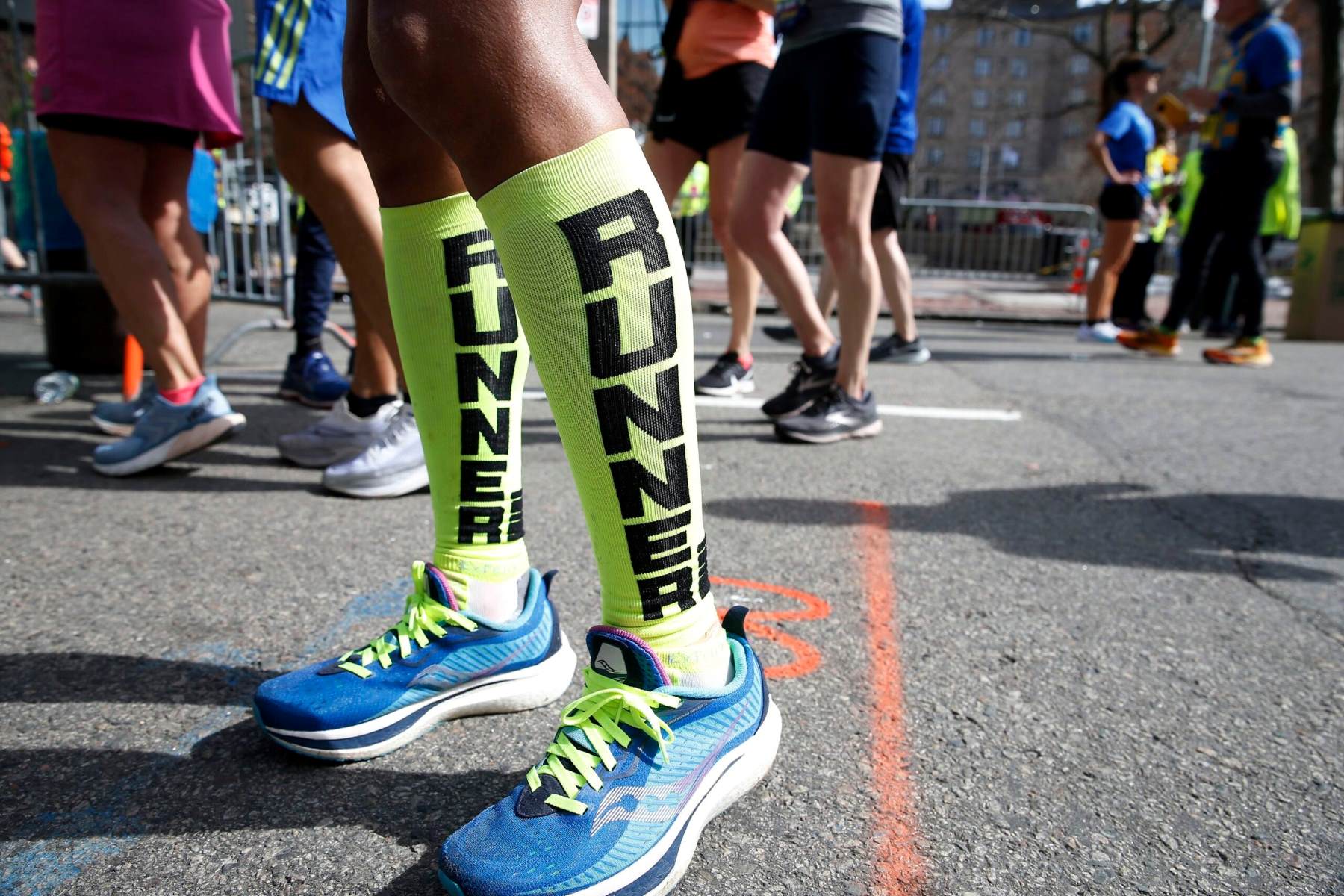Home>Races & Events>Marathon Guide>Everything You Should Know About Boston Marathon Qualifying Times


Marathon Guide
Everything You Should Know About Boston Marathon Qualifying Times
Published: February 22, 2024
Learn about Boston marathon qualifying times and get expert tips in our comprehensive Marathon Guide. Prepare to qualify and excel in the Boston marathon!
(Many of the links in this article redirect to a specific reviewed product. Your purchase of these products through affiliate links helps to generate commission for Therunningadvisor.com, at no extra cost. Learn more)
Table of Contents
Understanding Boston Marathon Qualifying Times
The Boston Marathon is one of the most prestigious and sought-after races in the world. To participate in this iconic event, runners must meet specific qualifying standards based on their age and gender. Understanding Boston Marathon qualifying times is crucial for anyone aspiring to compete in this historic race.
The qualifying times for the Boston Marathon are determined by the Boston Athletic Association (BAA) and are based on age and gender. These standards are designed to ensure that participants have the necessary level of fitness and running ability to complete the marathon safely and successfully. The qualifying times are periodically reviewed and adjusted to account for the popularity of the race and the number of applicants.
For each age and gender category, the qualifying time represents the benchmark that runners must achieve in a qualifying marathon. It's important to note that meeting the qualifying time does not guarantee entry into the Boston Marathon, as the actual registration process is competitive and based on a rolling admission system. However, achieving the qualifying time is the first essential step toward earning a spot in the race.
The qualifying times for the Boston Marathon are a reflection of the race's high standards and the level of competition among participants. They serve as a measure of the dedication and commitment required to excel in long-distance running. Aspiring Boston Marathon participants often set their sights on achieving these qualifying times as a significant milestone in their running journey.
Understanding the qualifying times also provides valuable insight into the level of preparation and training needed to meet the standards set by the BAA. It underscores the significance of consistent and disciplined training, as well as the importance of setting realistic goals based on individual capabilities and aspirations.
In essence, comprehending the Boston Marathon qualifying times is essential for runners who aspire to test their limits and be part of the historic tradition that defines the Boston Marathon. It represents a tangible goal that embodies the spirit of perseverance, dedication, and achievement in the world of long-distance running.
Factors Affecting Boston Marathon Qualifying Times
Several key factors influence the Boston Marathon qualifying times, shaping the standards that runners must meet to secure a coveted spot in this prestigious race.
1. Age and Gender
The qualifying times for the Boston Marathon are inherently linked to age and gender. The standards are tailored to reflect the physiological differences and performance capabilities across various age groups and between male and female runners. As a result, younger age groups generally have faster qualifying times, while older age groups have more lenient standards. This approach ensures that the qualifying times remain fair and equitable for all participants, regardless of age or gender.
2. Course Difficulty
The difficulty of the qualifying marathon course can significantly impact a runner's finishing time. Some marathon courses are known for their challenging terrain, elevation changes, or weather conditions, which can either hinder or enhance a runner's performance. As a result, the BAA considers the course difficulty when setting the qualifying standards, recognizing that not all marathon courses offer the same level of challenge.
3. Competitive Nature of the Race
The popularity and competitiveness of the Boston Marathon play a role in determining the qualifying times. As the race garners widespread interest and attracts a large pool of applicants, the BAA must establish qualifying standards that maintain the event's integrity and ensure a high caliber of participants. This factor underscores the significance of the Boston Marathon as a premier race and the need to uphold its esteemed reputation through stringent qualifying criteria.
Read more: The Lion Diet: Everything You Need To Know
4. Historical Trends
The BAA periodically reviews historical data and trends related to marathon performances, including average finishing times and the distribution of runners across age and gender categories. This analysis helps the BAA make informed adjustments to the qualifying times, ensuring that they remain relevant and reflective of the evolving landscape of marathon running. By staying attuned to historical trends, the BAA can adapt the qualifying standards to align with the capabilities and achievements of contemporary runners.
5. Safety and Logistics
The BAA also considers safety and logistical factors when establishing qualifying times. Ensuring that participants have the requisite level of fitness and endurance is crucial for their well-being during the marathon. By setting qualifying times that reflect the demands of the Boston Marathon course, the BAA prioritizes the safety and overall experience of all participants, reinforcing the race's commitment to excellence and responsible event management.
In essence, the factors influencing Boston Marathon qualifying times encompass a multifaceted approach that balances fairness, competitiveness, safety, and the evolving dynamics of long-distance running. Understanding these factors provides valuable insight into the rationale behind the qualifying standards and underscores the depth of consideration involved in maintaining the integrity and prestige of the Boston Marathon.
Training Tips to Meet Boston Marathon Qualifying Times
Training for a marathon, especially one as prestigious as the Boston Marathon, requires a comprehensive and disciplined approach. To meet the demanding qualifying times set by the Boston Athletic Association (BAA), runners must adhere to strategic training principles that encompass physical conditioning, mental fortitude, and meticulous preparation. Here are essential training tips to help aspiring participants meet the Boston Marathon qualifying times:
1. Establish a Structured Training Plan
Developing a well-structured training plan is paramount to building the necessary endurance and speed required to meet the qualifying times. The plan should include a balance of long runs, tempo runs, speed work, and recovery days. Gradually increasing weekly mileage and incorporating targeted workouts tailored to individual strengths and weaknesses are essential components of an effective training regimen.
2. Focus on Consistency and Gradual Progression
Consistency is key in marathon training. Gradually increasing mileage and intensity over several months allows the body to adapt and build endurance while minimizing the risk of injury. Consistent training also cultivates mental resilience, preparing runners for the rigors of the marathon distance.
3. Incorporate Strength Training and Cross-Training
Supplementing running with strength training exercises enhances muscular strength and overall stability, reducing the likelihood of overuse injuries. Cross-training activities such as cycling, swimming, or yoga can complement running, providing variety while promoting recovery and injury prevention.
4. Prioritize Recovery and Rest
Adequate rest and recovery are integral to the training process. Scheduling rest days and incorporating recovery techniques such as foam rolling, stretching, and proper nutrition are essential for allowing the body to adapt to training stress and minimize the risk of burnout or injury.
5. Simulate Race Conditions
Practicing under conditions similar to the Boston Marathon course, including hills and varying terrain, can better prepare runners for the race day challenges. Incorporating race-pace segments into long runs and familiarizing oneself with the demands of the course can instill confidence and mental preparedness.
Read more: All You Need To Know About IT Band Syndrome
6. Seek Professional Guidance and Support
Consulting with experienced coaches or joining a running group can provide valuable guidance, support, and accountability throughout the training process. Professional insight can help fine-tune training plans, address potential weaknesses, and optimize performance.
7. Emphasize Mental Preparation
Endurance events like the marathon necessitate mental resilience. Incorporating visualization techniques, positive affirmations, and mental toughness training can fortify the mind and bolster confidence, particularly during the latter stages of the race.
By integrating these training tips into their preparation, aspiring Boston Marathon participants can enhance their readiness to meet the challenging qualifying times. Each tip contributes to a holistic approach that encompasses physical conditioning, injury prevention, mental fortitude, and strategic planning, ultimately positioning runners for success in their pursuit of Boston Marathon qualification.
Strategies for Achieving Boston Marathon Qualifying Times
Successfully achieving the Boston Marathon qualifying times requires a strategic and multifaceted approach that encompasses training, race-day execution, and mental preparedness. Implementing the following strategies can significantly enhance a runner's prospects of meeting the demanding standards set by the Boston Athletic Association (BAA).
1. Goal-Oriented Training
Establishing clear and realistic training goals aligned with the Boston Marathon qualifying times is fundamental. By breaking down the overall qualifying time into manageable pace targets for various workouts and long runs, runners can systematically track their progress and adjust their training intensity accordingly. This goal-oriented approach fosters a sense of purpose and direction throughout the training process, reinforcing the commitment to achieving the qualifying times.
2. Race-Specific Workouts
Incorporating race-specific workouts into the training regimen is essential for simulating the demands of the Boston Marathon course. This includes practicing at goal race pace, integrating hill repeats to prepare for the course's undulating terrain, and incorporating long runs that mirror the race conditions. By familiarizing themselves with the specific challenges of the Boston Marathon, runners can refine their pacing strategies and build the necessary endurance to meet the qualifying times.
3. Strategic Pacing and Split Management
Developing a well-defined pacing strategy is crucial for optimizing performance and conserving energy throughout the marathon. By breaking down the race into manageable splits and adhering to a disciplined pacing plan, runners can mitigate the risk of starting too fast and succumbing to fatigue later in the race. Strategic pacing, coupled with prudent split management, is instrumental in ensuring that runners remain on track to achieve their target qualifying times.
4. Nutrition and Hydration Planning
Effective nutrition and hydration planning are integral components of achieving Boston Marathon qualifying times. Implementing a personalized fueling strategy during training and race day, as well as practicing fluid intake and electrolyte replenishment, can sustain energy levels and prevent depletion during the marathon. By optimizing their nutrition and hydration approach, runners can bolster their endurance and resilience, thereby enhancing their capacity to meet the qualifying standards.
5. Mental Resilience and Adaptability
Cultivating mental resilience and adaptability is paramount for navigating the inevitable challenges encountered during a marathon. Visualizing success, embracing a positive mindset, and preparing for unforeseen circumstances contribute to mental fortitude. By developing the ability to adapt to race day variables and overcome moments of discomfort, runners can sustain their focus and determination, ultimately bolstering their prospects of achieving the Boston Marathon qualifying times.
Read more: All You Need To Know About Hamstring Strains
6. Strategic Race Selection
Choosing qualifying races strategically can significantly impact a runner's ability to achieve the Boston Marathon qualifying times. Selecting races with favorable course profiles, conducive weather conditions, and a supportive race environment can optimize the likelihood of attaining the required finishing time. By evaluating potential qualifying races based on these criteria, runners can enhance their prospects of meeting the standards set by the BAA.
By integrating these strategic approaches into their training and race preparation, runners can elevate their readiness to meet the rigorous Boston Marathon qualifying times. Each strategy contributes to a comprehensive framework that encompasses physical conditioning, mental fortitude, and tactical acumen, positioning runners for success in their pursuit of Boston Marathon qualification.
Common Mistakes to Avoid When Trying to Meet Boston Marathon Qualifying Times
Successfully meeting the Boston Marathon qualifying times necessitates a meticulous and strategic approach to training and race preparation. However, several common mistakes can hinder runners' efforts to achieve these demanding standards. By recognizing and addressing these pitfalls, aspiring Boston Marathon participants can enhance their prospects of qualifying for this prestigious event.
1. Inadequate Long-Term Planning
One prevalent mistake is embarking on the journey to meet Boston Marathon qualifying times without a well-defined and sustainable long-term plan. Rushing into intense training without allowing sufficient time for gradual progression and adaptation can lead to overtraining, burnout, and increased risk of injury. Long-term planning that encompasses progressive mileage buildup, periodized training cycles, and adequate recovery periods is essential for sustainable improvement and injury prevention.
2. Ignoring Recovery and Rest
Underestimating the importance of rest and recovery is a common pitfall that can impede progress toward meeting qualifying times. Failing to incorporate rest days, recovery techniques, and adequate sleep into the training regimen can compromise the body's ability to adapt and improve. Overtraining and insufficient recovery can lead to diminished performance, heightened injury susceptibility, and overall stagnation in training progress.
Read more: All You Need To Know About Strava Summit
3. Neglecting Strength and Cross-Training
Overemphasizing running while neglecting strength training and cross-training is another prevalent mistake. Building muscular strength, addressing imbalances, and enhancing overall stability through targeted strength exercises can fortify the body against injury and improve running efficiency. Incorporating cross-training activities such as swimming, cycling, or yoga can provide variety, aid recovery, and reduce the repetitive stress associated with running.
4. Inconsistent Training
Consistency is paramount in marathon training, and inconsistency in training frequency or intensity can hinder progress toward meeting qualifying times. Irregular training patterns can impede the body's adaptation to increased mileage and intensity, compromising overall fitness gains. Establishing a consistent and sustainable training routine is crucial for building endurance and improving performance over time.
5. Overlooking Race-Specific Workouts
Failing to incorporate race-specific workouts that simulate the demands of the Boston Marathon course is a common oversight. Without adequate preparation for the course's terrain, elevation changes, and potential weather conditions, runners may struggle to perform optimally on race day. Integrating race-specific elements into training, such as hill repeats and long runs that mirror the race conditions, is essential for developing the necessary physical and mental readiness.
6. Neglecting Mental Preparation
Underestimating the significance of mental preparation and race-day mindset is a prevalent mistake among aspiring Boston Marathon qualifiers. Endurance events like the marathon necessitate mental resilience, positive self-talk, and visualization techniques to navigate the inevitable challenges. Neglecting mental preparation can compromise a runner's ability to sustain focus, manage discomfort, and execute race strategies effectively.
By acknowledging and actively avoiding these common mistakes, runners can enhance their readiness to meet the rigorous Boston Marathon qualifying times. Addressing these pitfalls contributes to a holistic and sustainable approach to training and race preparation, ultimately bolstering runners' prospects of achieving their qualification goals.










